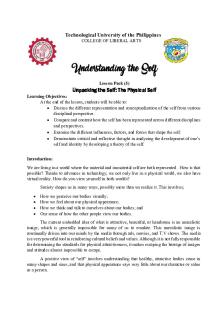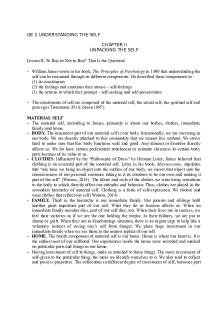Understanding The Self Lesson 2 PDF

| Title | Understanding The Self Lesson 2 |
|---|---|
| Author | Marcella Grace Dulce |
| Course | Understanding the Self |
| Institution | Technological University of the Philippines |
| Pages | 4 |
| File Size | 236.9 KB |
| File Type | |
| Total Downloads | 274 |
| Total Views | 336 |
Summary
Technological University of the Philippines COLLEGE OF LIBERAL ARTSUnderstanding the SelfLesson Pack (2)The Self f rom Vari ous Perspective: SociologyLearning Objectives:At the end of the lesson, students will be able to: - Discuss the different representation and conceptualization of the self from ...
Description
Technological University of the Philippines
COLLEGE OF LIBERAL ARTS
Unde Understanding rstanding the Sel Selff Lesson Pack (2)
The Self from VVarious arious Perspecti Perspective: ve: Sociolo Sociology gy Learning Objectives: At the end of the lesson, students will be able to: • Discuss the different representation and conceptualization of the self from various disciplinal perspective. • Compare and contrast how the self has been represented across different disciplines and perspectives. • Examine the different influences, factors, and forces that shape the self. • Demonstrate critical and reflective thought in analyzing the development of one’s self and identity by developing a theory of the self.
SOCIOLOGY “Not only is the ‘self’ entwined in society; it owes in society its existence in the most literal sense.” -Theodor Adorno The Self as a Product of Modern Society Among Other Constructions Sociologists are concerned with questions about the person in the community. For example, they ask questions, like; “How does society influence you?” “How do affect society?” More importantly, “Who are you as a person in the community?” Sociology posits that socially formed norms, beliefs and values come to exist within the person to a degree where these become natural and normal, thus, developing the person’s self-identity. Modernization has significantly changed society, and this has affected how an individual build and develop his or her self-identity. Pre-modern society was centered on survival. People behaved according to social rules and traditions while the family and the immediate environment provided supervision on how to get through life. Choosing where to live, what line of work to do, and even who to marry was very limited.
Modernization, however ha improved people’s living conditions. A person in the modern society is free to choose where to live, what to do and who to be with. However, stability has also decreased as traditions and traditional support systems, such as the family, have decreased in importance. In modern societies, individualism is dominant, and developing one’s self identity is central (Giddens, 1991). Key Characteristics of Modernity According to Giddens (1991), the most patent, major characteristics of modernity are: 1. Industrialism- the social relations implied in the extensive use of material power and machinery in all processes of production. 2. Capitalism- a production system involving both competitive product markets and the commodification (putting a price tag) of labor power. 3. Institutions of Surveillance- the massive increase of power and reach by institutions, especially in government 4. Dynamism- the most evident characteristic of modern society. Dynamism is characterized as having vigorous activity and progress. In a modern society, life is not a predetermined path with limited options based on location, family, or gender, it is a society full of possibilities. Everything is subject to change, and changes happen much more rapidly than ever before in human history. Social Groups and Social Networks Sociologist Georg Simmel expressed that people create social networks by joining social groups. A social group is described as having two or more people interacting with one another, sharing similar characteristics, and whose members identity themselves as part of the group. An example of social groups is your family, your barkada, your classmates. Meanwhile, social network refers to the ties or connection that link you to your social group. The connection you have with your family is your blood relation; the connection your have in your barkada is your friendship; and the connection you have with your classmates is the common interest to learn. A social group is either organic or rational. An organic group is naturally occurring, and it is highly influenced by your family. This is usually formed in a traditional society because there is little diversity in these communities. Sociologist Georg Simmel stated that you join these groups because your family is also part of it, in the first place. He called it Organic Motivation. Simmel noted that the positive effect of organic groups is rootedness. This means the foundation of the social network runs deep, thus, giving the person a sense of belongingness. The downside, however, is that organic group imply less freedom and greater social conformity. You are expected to act and behave according to your community’s standards. Rational groups occur in modern societies. Modern societies are made up of different people coming from different places. The family in modern societies is not the main motivation when joining rational social groups. Rational groups are formed as a matter of shared self-interest; moreover, people join these group out of their free will. Simmel called this Rational Motivation. Rational groups imply greater freedom, especially the freedom of movement. Relationships based on self-interest are not as embedded as organic relationships. Interest change and when they do,
group members change. The relationship between rational social networks is tenuous, and the person feels no meaningful connection with the others. Mead and the Social Self “A multiple personality is in a certain sense normal.” --George Herbert Mead Have you ever watched someone do something? Of course, you have. Even as babies we watch others, like mom or dad do something. Why do we do that? It’s how we learn. We learn to do things; we learn what’s safe and what’s not. When we watch other people, we learn a lot about ourselves. Moreover, when we watch others, we also come to understand people. We understand why they behave the way they do; what identity they claim; and what role play in society. On the other hand, while you get to know yourself and understand others by watching people, how can you understand yourself? Can you “watch” yourself as objectively as you do the others? This is the question that sociologist George Mead explored. George Herbert Mead was a sociologist from the late 1800s. he is well known for his theory “Theory of the Social Self.” Mead’s work focused on how the self is developed. His theory is based on the perspective that the self is a product of social interactions and internalizing the external (i.e., other people’s) views along with one’s personal view about oneself. Mead believed the self is not present at birth; rather it develops over time through social experiences and activities. Developing the Self Mead developed a concept that proposed a different stage of self-development. These stages are language, play and game. According to Mead, self-development and language are intimately tied. Through shared understanding of symbols, gestures and sound, language gives the individual the capacity to express himself or herself while at the same time comprehending what the other people are conveying. Language sets the stage for self-development. The second stage for self-development is play. At this level, individuals role-play or assume the perspective of others. Role playing enables the person to internalize some other people’s perspectives; hence, he or she develops an understanding of how the other people feel about themselves (and about others, too) in a variety of situations. Meanwhile, the game stage is the level where the individual not only internalizes the other people perspectives, he or she is also able to take into account societal rules and adheres to it, according to Mead, the self is developed by understanding the rule, and must abide by it to win the game or be successful at an activity. Two Side of Self: I and Me Mead sees the person as an active process, not just a mere reflection of society. He further proposed two interactive facets of the self: the ‘I’ the and ‘me.’ The ‘me’ and the ‘I’ have didactic relationship, which is like a system of checks and balances. According to Mead, ‘me’ is the product of what the person has learned while interacting with others and with the environment. Learned
behaviors, attitudes, and even expectations compromise the ‘me.’ The ‘me’ exercises social control over the self. It sees to it that rules are not broken. On the other hand, the ‘I’ is that part of the self that is unsocialized and spontaneous. It is the individual’s response to the community’s attitude toward the person. The ‘I’ presents impulses and drives. It enables him/her to express individualism and creativity. The ‘I’ does not blindly follow rules. It understands when to possibly bend or stretch the rules that govern the social interactions. It constructs a response based on what has been learned by the ‘me.’
Assessment: Thought Piece #2 • Ask 10 people, it can be your family, friends, classmates and even strangers to tell something about their impressions on you. It can be positive or negative. • What are your thoughts after hearing those impressions? • Essay type.
Thought Piece Rubric Ideas Organization of thoughts Relevance to the topic Mechanics (Use of language, grammar, punctuation etc.)
35% 30% 25% 10%
REFERENCE:
Otig, V. S., Gallinero, W. B., Bataga, N. U., Salado, F. B., & Visande, J. C. (2018). A Holistic Approach in Understanding the Self. Malabon City, Philippines: Mutya Publishing...
Similar Free PDFs

Understanding The Self Lesson 2
- 4 Pages

Understanding The Self Lesson 8
- 6 Pages

Understanding The Self Lesson 9
- 10 Pages

Understanding The Self Lesson 5
- 4 Pages

Understanding The Self Lesson 11
- 14 Pages

Understanding The Self Lesson 1
- 8 Pages

Understanding The Self Lesson 3
- 3 Pages

Understanding The Self Lesson 6
- 4 Pages

Understanding The Self Lesson 4
- 9 Pages

Understanding the Self- Reviewer
- 7 Pages
Popular Institutions
- Tinajero National High School - Annex
- Politeknik Caltex Riau
- Yokohama City University
- SGT University
- University of Al-Qadisiyah
- Divine Word College of Vigan
- Techniek College Rotterdam
- Universidade de Santiago
- Universiti Teknologi MARA Cawangan Johor Kampus Pasir Gudang
- Poltekkes Kemenkes Yogyakarta
- Baguio City National High School
- Colegio san marcos
- preparatoria uno
- Centro de Bachillerato Tecnológico Industrial y de Servicios No. 107
- Dalian Maritime University
- Quang Trung Secondary School
- Colegio Tecnológico en Informática
- Corporación Regional de Educación Superior
- Grupo CEDVA
- Dar Al Uloom University
- Centro de Estudios Preuniversitarios de la Universidad Nacional de Ingeniería
- 上智大学
- Aakash International School, Nuna Majara
- San Felipe Neri Catholic School
- Kang Chiao International School - New Taipei City
- Misamis Occidental National High School
- Institución Educativa Escuela Normal Juan Ladrilleros
- Kolehiyo ng Pantukan
- Batanes State College
- Instituto Continental
- Sekolah Menengah Kejuruan Kesehatan Kaltara (Tarakan)
- Colegio de La Inmaculada Concepcion - Cebu





